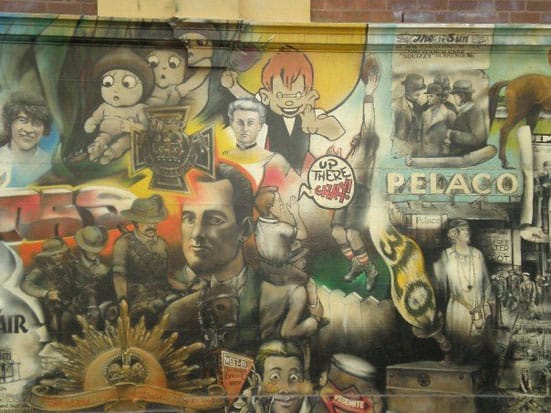Dear Artvehicle,
I bring you my first and hopefully not last piece from far too hot
Melbourne. This postcard is unfortunately delayed due to my sheer
excitement at being away from the cold and grey London streets of
Hackney to the Brightonesque beach front of St Kilda.
Melbourne has an array of galleries spotted about the city, especially
independent ones in the Brunswick Street area. However, the ones that
grabbed my attention were the large main ones. Unlike other big cities
all the well known large galleries are within a fifteen minute walk.
The highlights being The National Gallery of Victoria (NGV), The
Australian Centre for Contemporary Arts (ACCA), Victoria Arts Centre
(VAC) and Australian Centre for the Moving Image (ACMI).
The NGV, like any other national gallery, has its classic permanent
collection with a mix of genres and eras, but should be awarded special
credit for the temporary exhibitions. Krishna: Love and Devotion in the
Asian Art Temporary Exhibition Space combined a collection of
iconography including jewellery, textiles and sculpture along with
contemporary photography. Beautiful, bright and fascinating, this small
exhibit admirably extends the museum's already extensive permanent
collection of Asian art. Modern Britain 1900-1960 is the large
temporary exhibition at the moment, it has over 250 masterworks that
have been collected from the Australian and New Zealand art
collections. Such an incredible array of paintings and sculpture
unlikely to ever be combined again, and it was thrilling to see the
progression from the beginning of the century through the war and into
the modern period. The highlight for me was Alvaro Guevara's
perculiarly bewitching portrait Mrs Fairbaim (1919).
The ACCA, while very impressive from the exterior with its steel and
rust red structure styling, is distinctly not so large from the inside.
The selection of artists is varied but very video heavy and at times
badly installed. The highlight for me were two Tracy Moffat video
pieces, Artist (2000) and Doomed (2007), however, these were slightly
spoiled by the lack of seating forcing you to crowd around a small
television on the floor, and by sounds from other pieces, not to
mention the confiscation of my water even on a 30C+ degree day.
The ACMI surprised me, to be honest. It is a large building situated in
the monumental Federation Square, moments away from the bustling city
centre entrance to Flinders Street Station. The calm, quiet and sheer
size seemed ideal for Replay Marclay, the first solo exhibition to be
held in the new Screen Gallery. It was interesting to see a Marclay
exhibition without his usual sculptural additions of record covers
-don't get me wrong I really love them -but actually this exhibition
worked on its own with just sound and vision. A heavenly air
conditioned room welcomes you as you descend a staircase in darkness
with a silent piece to watch Mixed Reviews (American Sign Language),
1999-2001. The massive dark room had numerous concealed spaces coming
off it for pieces concentrating on sound. The best of this, Crossfire
2007, placed the viewer in the middle of the box-room and comprised
four synchronised video projections each playing a different violent
film. Gun fire from each movie, however as soon as you turn to see the
image it has stopped and another screen is screaming gunfire. You
become the victim being shot at; trapped amongst all the noise. Marclay
is said to have tried to "turn the firearms into percussion
instruments." Interview Magazine said of Christian Marclay "Music like
you've never seen before ... art like you've never heard before", and
they are exactly right.
The exhibition at the VAC was the one that probably surprised and
impressed me the most. Nick Cave: The Exhibition is a personal insight
into Australian writer, singer and musician. It is a behind-the-scenes
look at the inspiration and imagination behind Cave's work. The
exhibition includes many personal items including a mock up of his home
library, his Kylie bag, some pieces of his art collection by Louis Wain
(painter of comedy cats) and notebook upon notebook of pictures and
hand written lyrics. The exhibition is also scattered about with small
wall-mounted cupboards that, when opened, play Nick Cave talking about
a variety of subjects, including his favourite art which includes the
Rothko room at the Tate, The Beheading of John The Baptist at the
National Gallery and late Simeon Solomon (one of which he owns). There
is a deep religious influence in the exhibition and Cave's life from
prayer cards in some notebooks, to religious idol statues and small art
works. Even if you are not a fan or know anything about Nick Cave it
doesn't matter because it is a fascinating look into someone's life and
how they think, what has happened to them and how they have been
inspired.
On a final word, art in Melbourne in not restricted to the galleries
but it all over the city, from a decorative grate to incredible
architecture and graffiti everywhere. However, the graffiti is unlike
the usual classless 'tags' you see when coming in and out of Waterloo,
it is made as art and treated as art being given special places in the
city, especially the suburbs. Melbourne is certainly a city full of
inspiration and is not short on art, so any of you who think it is too
far, forget about it and come over because while you are in coats,
gloves and scarves I am in as little as possible by the beach or in an
air conditioned gallery while it is between 28 and 41 degrees.....keep
it in mind!
MMM

Postcard; Graffiti Art in Richmond, Melbourne, Australia
Photo by Marianna M MacGilp